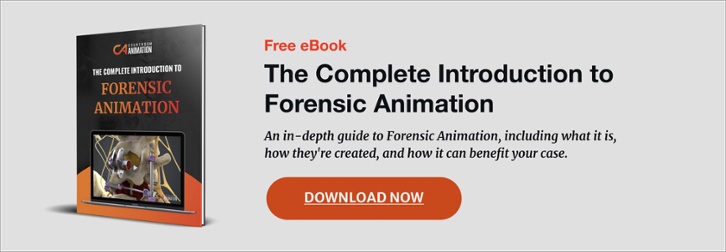What is a legal graphic?
A legal graphic, or legal animation, is used in civil or criminal cases to provide the jury, judge, or other legal audiences a visual representation of your case’s key facts.
A picture is worth a thousand words. When it comes to litigation, this is even more true. Whether you’re in settlement discussions or trial, a legal graphic can help showcase evidence, explain an expert witness’s testimony or deposition, and accurately evaluate liability.
It’s been scientifically proven that presentations with visual components are about 43% more persuasive than those without. A legal graphic is referenced almost interchangeably with the term legal animation, but a legal graphic can also be a still graphic of a 3D model.
The first 3D computer generated graphic was of a human face and a hand that originally appeared in the 1972 experimental short film A Computer Animated Hand. 3D models and rendering techniques have come a long way from that first iteration.
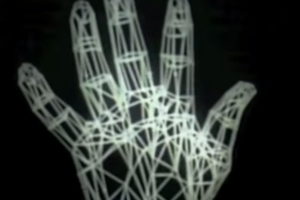
First 3D Computer Animated Hand (1972)

Modern 3D Animated Person – Sample from Courtroom Animation
Now, 3D legal graphics have evolved to also support various types of civil cases, such as:
- Accident Reconstruction Animations
- Aviation Accidents
- Personal Injury
- Product Liability
- Environmental Law
- Officer Involved Shootings
- Traumatic Brain Injury
- And more.
How Legal Graphics Support Civil Attorneys
We understand that there are many factors that go into developing and presenting accurate legal graphics, so we’ve compiled several blog posts and case studies to help you learn how courtroom graphics are used:
- How Do Legal Graphics Benefit My Case?
- Are Legal Animations and Graphics Admissible?
- Are Litigation Graphics Helpful for Settlement Discussions, or Only in Trial?
- Will Law Graphics Help a Jury Remember and Understand My Case?
- Case Study: Is There a Use Case for Legal Graphic Services?
- Is Legal Video or Auditory Testimony Better for a Jury?
- Case Study: Are Medical Legal Graphics Useful for Both Plaintiff and Defense Attorneys?
- Do I Really Need Trial Graphics for My Case?

How to Prepare Your Case for Working with a Forensic Animation Studio
Much like legal graphics, forensic animation also plays a large part in civil cases. In this checklist, you will learn:
- How to prepare your case to work with an animator
- Understand the timeline of injury animations
- Plan out critical dates and times, and more!
Courtroom Animation’s Legal Graphic & Animation Example
Our animations are always scientifically accurate, which is why we have a 99% admittance rate in more than 2,000 cases in the United States. Our 3D animation team has also had the privilege of a handful of the worlds top news and editorial forums featuring our work. To lead your case to a favorable verdict or settlement, our legal graphic services can:
- Demonstrate moving machinery parts
- Highlight a changed environment
- Speed up and slow down time
- Highlight the most relevant information
- Walk viewers through a case’s process
- Organize technical data to help understanding
- Use imagery to communicate complex concepts
How Do Legal Graphics Benefit My Case?
It’s common for a case to have many complex parts that need explaining during litigation. An expert witness might have a very technical report to support your argument, but the vital information might confuse a jury.
Legal graphics help support your core argument in these four areas:
1. Simplify the Complex
If your case has multiple parties or eyewitness accounts, you can validate or invalidate those arguments.
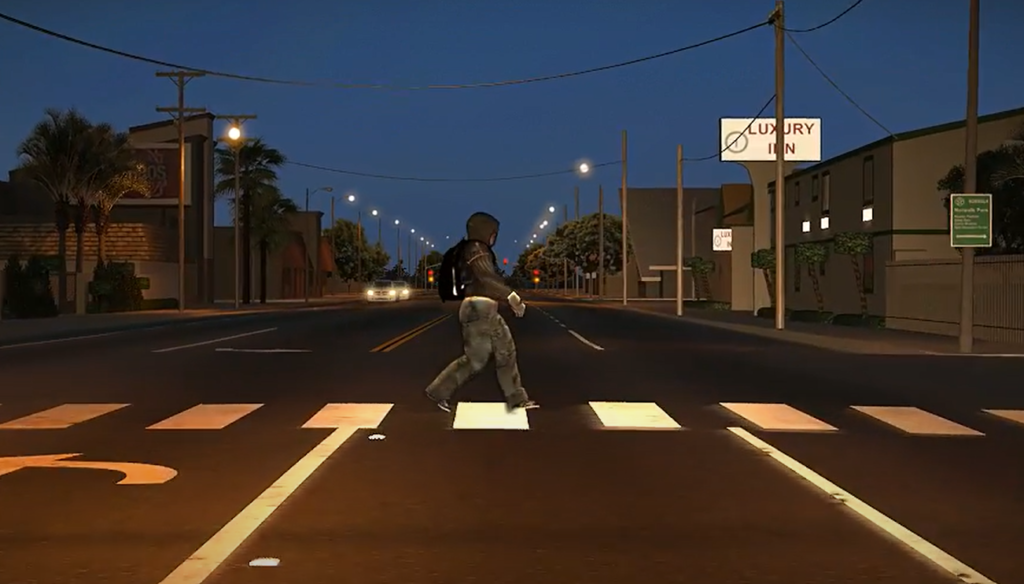
This legal animation brought a realistic view to the incident and helped the court reach a verdict faster. A legal graphic can achieve the same thing in trial or during settlement discussions.
2. Reinforce Your Expert’s Position
A legal graphic is an easy way to highlight the accuracy of your expert’s argument. To start, your legal graphic team can partner with any type of expert brought in, such as an aviation accident reconstruction specialist, who could ensure the trial graphic is accurate.
Any unclear testimony can be simplified with both a verbal explanation from an expert on the subject, and a convincing litigation visual.
3. Impact Every Phase of Litigation
Both plaintiff and defense attorneys can leverage litigation graphics to support their case during:
- Motion practice
- Settlement discussions
- Mediation hearings
- Focus groups
4. Increase Comprehension and Retention
Not only do legal graphic services help clarify the facts to a jury, but they also help mediators and even the opposing counsel understand your client’s case.

Whether it’s a complex medical procedure, a system schematic, architectural model, or a medical device, compelling legal graphics summarize the key themes and core arguments of your case.
Helpful tip: When it comes to submitting trial graphics or courtroom illustrations to be admitted, it’s important that the visual presents a fair and accurate representation of the evidence.
Are Legal Animation and Graphics Admissible?
A common question our clients have is, how can you as an attorney, no matter what stage of the legal process you’re in, ensure your demonstrative exhibits are admitted by a judge?
Remember that legal animations are not computer simulations. Attorneys might use the terms animation and simulation interchangeably, but referring to an animation as a simulation can cause misunderstandings
Here are five straight-forward procedures that an attorney can employ to ensure a legal animation, or a legal graphic, is admissible.
1. Share your legal graphics ASAP with the opposing counsel
We recommend sending them the animation before or at the start of mediation hearings if possible, as many case’s finish during that stage of litigation.
2. Introduce it to your party’s expert
For both the plaintiff and defense parties, their expert witnesses are a core part of establishing authority and accuracy. That’s why it’s vital to discuss the court visual during your expert’s deposition while the opposing counsel is there.
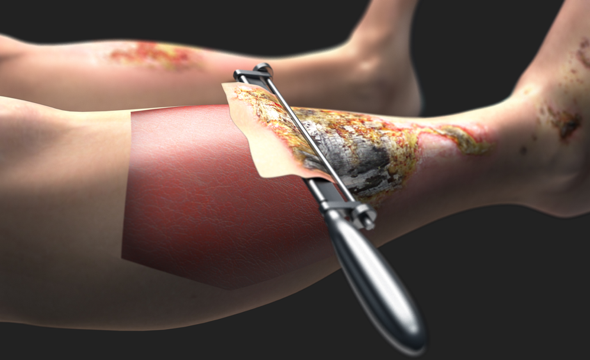
Our experienced team recommends sending them the legal animation before, or at the start of, mediation hearings.
3. Show the court graphic to the opposing expert
It’s just as critical to present your legal animation to the opposing expert as it is to your own.
During the opposing expert’s deposition, get them to admit the legal graphics are reasonably accurate. If they don’t, ask them to articulate precisely why and how it may not be precise or detailed enough. For example, they can discuss the accuracy of a product liability graphic, such as a car’s schematics.
“I’ve never had admissibility problems at trial with their work. Their commitment to helping us with expert and trial rigid deadlines, while putting together a beautiful product is rare to find.”
– Jon Teller, Attorney at Wilshire Law Firm
If they do accept it as reasonably accurate, then you can be even more confident in its admissibility. An animation is never fabricated evidence, it is always based on data, reports or/and testimony.
4. Have witnesses testify to its accuracy
When this exercise is completed in the deposition stage of the legal process, you can attach the witness testimony to the motion in limine opposition. This allows the judge to see that the trial graphic was created with a knowledge-based foundation.
Helpful Tip: DO NOT SAVE THIS FOR THE TRIAL!
A courtroom graphic helps in many ways for a jury or other legal parties to agree with either the defense or plaintiff attorney’s argument.
5. Put your legal animation on the exhibit list early
If you are in the pleadings, discovery, pre-trial, or the trial stage of a legal case, you can use a scientifically accurate legal visual to gain the upper hand on the opposing counsel.
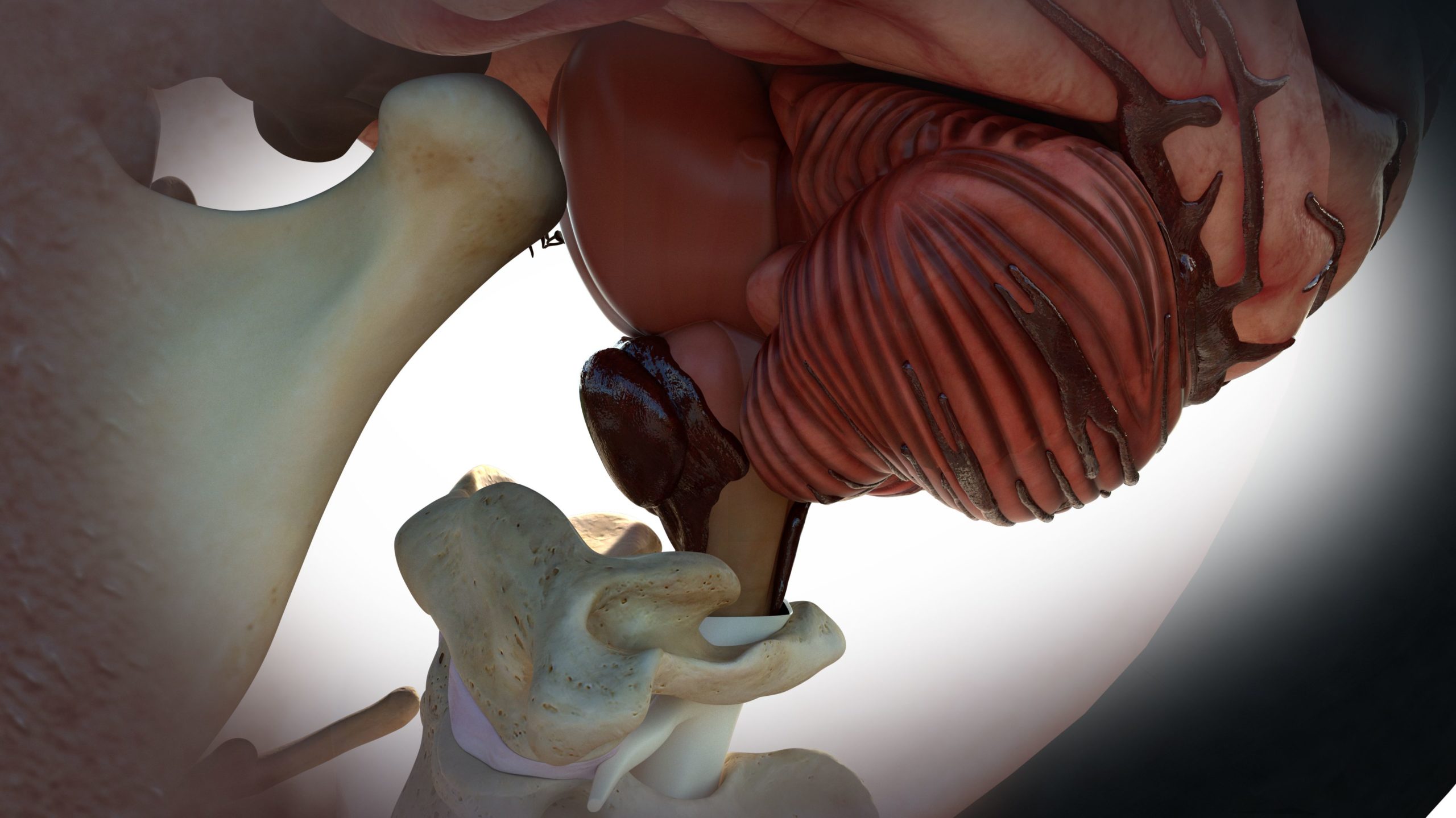
Submitting your legal animation to the exhibit list well in advance of trial puts the opposing counsel on notice that you intend to present it to the jury. This reveals that you are confident in your core argument, and are working with a professional court animation team.
Are Litigation Graphics Helpful for Settlement Discussions, or Only in Trial?
It’s often assumed that animation and graphics are only viable for cases that go to trial, but this is not true. It is important to use every tool you can to persuade a jury during trial that your argument is the correct one to help them evaluate liability.
The cost of producing these legal graphic services has significantly dropped in the past decade. In addition, modern culture has trained humans to consume information in digital formats, which means that your audience, whether it’s a jury, judge, or mediator, will respond more favorably to a legal animation.
Here are five areas where litigation graphics create leverage in settlement discussions.
Because legal graphics are in digital forms, a legal team can create a presentation that can be shared with any decision maker that is not present during the discussion.
Below is an example of our legal graphic services to create a visual that was used in mediation:
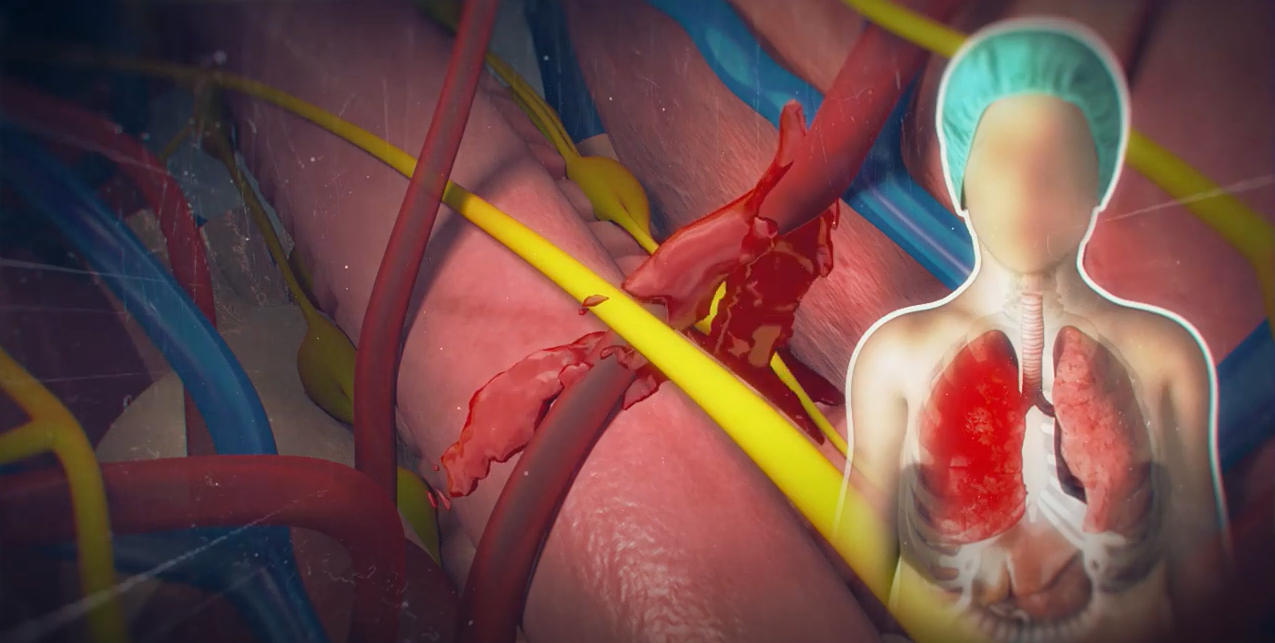
There are also many advantages to using litigation graphics in settlement talks, especially while in a judge’s chambers. With a well-done presentation you ensure that the judge will be able to understand your case, even if it is a complex situation, which can tip the settlement in your favor.
A well-prepared team that shows up to direct settlement talks with an informative legal animation can highlight the weaknesses in the case. This encourages the opposing counsel to agree to a settlement, rather than risk being embarrassed.
In today’s modern world, settlements can happen via email. Litigation graphics and trial animations can easily be sent along with an email. This shows the opposition that you are ready for trial with your trial graphics.
Mock settlement discussions and mediations are common when large amounts of money are on the line. This is the perfect time to test your law graphics and legal animations on the mediator.
Will Law Graphics Help a Jury Remember and Understand My Case?
Memory research has proven that visuals create long-term memories better than someone reading text or listening to a speech. 90% of information transmitted to the brain is visual. Therefore trial exhibits, classified as demonstrative evidence, are crucial for an attorney. They highlight the most impactful elements of your case, and help the jury retain information.
Thus law graphics, coupled with the science of human memory, add a compelling aid to your court case.
“Short-term memory refers to information processed in a short period of time. Long-term memory allows us to store information for long periods of time, including information that can be retrieved consciously or unconsciously.”
– The Neuroanatomical, Neurophysiological and Psychological Basis of Memory: Current Models and Their Origins
Adding a trial graphic to your presentation, no matter what phase of the legal process you’re in, makes your argument more memorable. Court animations also help the viewers feel more involved and focused.
You might be asking yourself…
- What goes into creating a legal graphic to ensure it’s memorable?
- In what types of cases would you want to use legal animation?
- What does it cost, and how can you be confident in its admissibility?
Download this free eBook to answer these questions on
legal graphics, forensic animation, and more.
Case Study: Is There a Use Case for Legal Graphic Services?
It’s always helpful for litigation attorneys to really understand how legal graphic services support their key arguments. One way this article can demonstrate that is by providing a use case where a plaintiff attorney asked for a court graphic, and used it to help him win a nearly 7-figure settlement.

This case revolved around a car accident reconstruction animation. A sedan, avoiding a slowing down blue truck ahead of it, braked and quickly changed lanes. The tanker truck driver, located behind the sedan, did not change lanes or brake enough, resulting in a rear-end collision with the truck that was in front of the sedan.
The rear-ended truck driver sued the tanker truck driver, claiming that the truck driver had enough time to react. In vehicle accident reconstructions, it can be quite difficult for a party to verbally describe the position of moving vehicles and the progression of events. Without clear visuals, explaining the timing between various cars and their interactions on a highway is hard to follow.
Courtroom Animation’s team of visual strategists, designers and developers can create and customize your court presentation for any case that needs legal graphics, medical legal animations, court animations, forensic animation, and more.
Is Legal Video or Auditory Testimony Better for a Jury?
Did you know that only 2.5% of people can multitask effectively? This means that it’s likely the jurors for your case are not multi-taskers.
In a civil case, one legal video is worth one thousand trial graphics. While legal graphics are proven to be compelling visual aids, a legal video is better at capturing attention.

The jury listens to your presentation, processes visual stimuli, thinks about the case, and more. When a person isn’t focused, they can’t fully retain information. This means a jury without law graphics or any visuals is going to have a hard time remembering your argument.
Want to learn how you can work with an animation team
to create a legal video? Download this free checklist!
The attorney could describe how their client hit someone and caused an injury. This explanation could be flawless, but if the jury took a break and returned to the trial, the critical details could be forgotten in their short-term memory. That’s why an injury animation, or even a surgery animation, could support your case.
A legal animation is the optimal method to make sure there’s a cohesive narrative behind the witnesses you call. A legal video can help condense that narrative together and bring it to life with accurate 3D models and realistic depiction of motion.
Helpful tip: Bring in a legal video specialist early in the legal process to get the maximum amount of benefits.
Both plaintiff and defense attorneys can use law graphics to support their court techniques. Humans are visual creatures, which is why a jury will have an easier time evaluating liability if you have a legal video.
“The jury was rapt every time we played [the legal video] in court and they asked to show it again while deliberating. After the verdict came down, many of the jurors told us that they really liked the video. It brought our case home!”
– Lynberg & Watkins
Case Study: Are Medical Legal Graphics Useful for Both Plaintiff and Defense Attorneys?
Courtroom Animation had created medical legal graphics on behalf of the plaintiff in a medical malpractice case. This case centered on a doctor that delivered a misdiagnosis and, acting on that misdiagnosis, performed a surgery that was not required. This resulted in life-long medical conditions for that plaintiff attorney’s client. This case settled; in fact, mediation discussions were settled in one day.
While this was a plaintiff use-case, legal graphics are useful for defense attorneys. An animation team creates defense-centered around medical legal graphics, or any other type of legal animation that would fit a defense attorney’s needs.
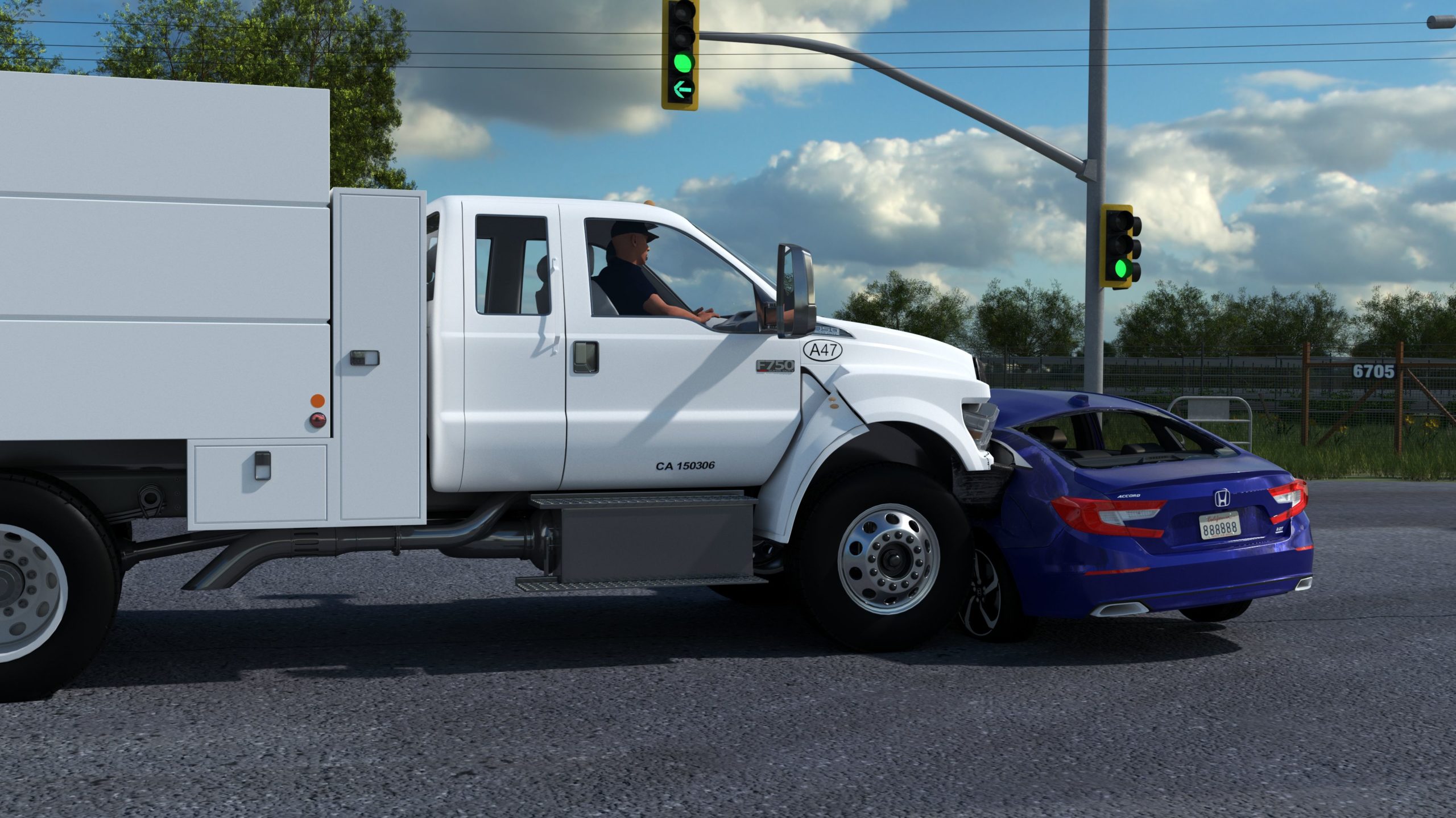
The litigation graphics in this case created by Courtroom Animation helped evaluate liability and demonstrate the severity of the plaintiff’s life-long injuries. This supported the plaintiff attorney’s argument of why the doctor shouldn’t have done this surgery and was liable.
However, if this was a different patient case from the defense attorney’s perspective, a medical animation could be created to show that a doctor could see exactly what they were doing and were correct in their diagnosis. Even non-medical related cases can use a court graphic or animation to support a defense attorney’s case, such as accident reconstruction animations.
Our team ensured that the legal animation was scientifically accurate, and therefore admissible, by having close coordination between our developers, the attorneys, and the medical expert witnesses.
“Courtroom Animation was instrumental in our ability to show the experimental nature of the procedure. Their ability to create the rendering of the animation helped the mediator understand our case and enabled our expert to walk the mediator through the procedure step by step to show the deviations from the standard of care.”
– Michael Greico, Attorney at Romanucci & Blandin Law Firm
Do I Really Need Trial Graphics for My Case?
At trial, the stakes are high. Therefore it is common for civil attorneys to use a court visual during a presentation. To ensure admissibility and maximize the impact on the jury, it’s crucial that any trial graphics you use are accurate and compelling.
How can you decide if your case needs a legal graphic?
Both plaintiff and defense attorneys have found that legal graphics lead to a more favorable verdict, no matter the type of case they’re representing. If your client was in a car crash, then a legal graphic could illustrate the mechanism of injury. Or it could illustrate other viewpoints that the plaintiff could have taken to avoid the accident.
Does the Opposing Counsel Have Trial Graphics?
If yes…
The jury could see your argument as unprepared or less persuasive in comparison. Graphics, and legal videos, have been shown to be very influential to juries.
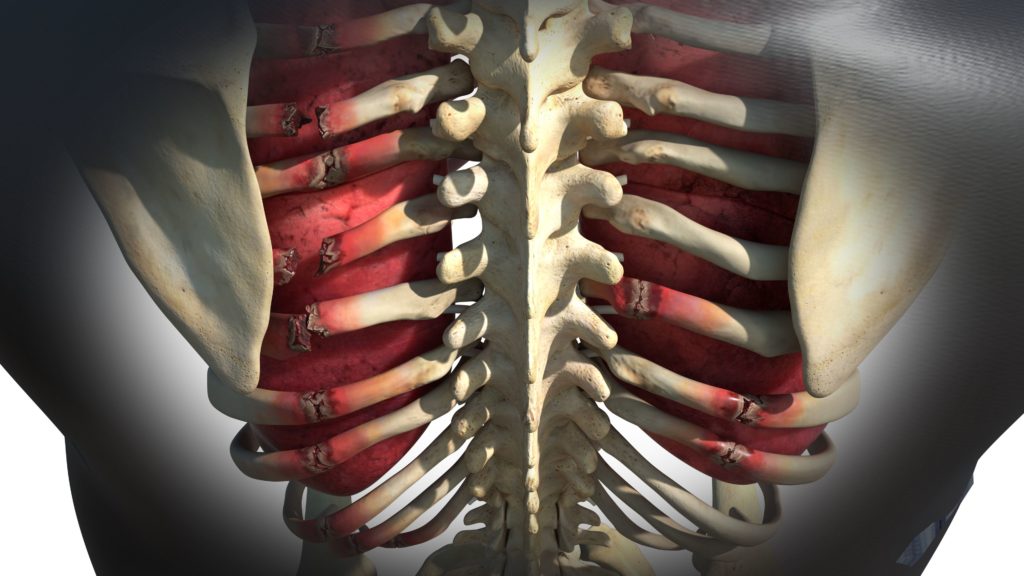
Take these notes into consideration when the opposing attorney presents their legal graphic:
- Determine if the court graphics match the underlying data set.
- If it’s a legal animation, check if they speed up or slow down time in inappropriate ways.
- Study if they use cameras with improper fields of view to represent human eyesight.
- Note if the visuals use bad lighting to make objects more or less obvious.
If not…
If the opposing counsel does not have a trial graphic, that gives you an opportunity to gain the advantage. A law graphic helps the jury remember your case and more. A litigation graphic also improves your chances of a pre-trial settlement. When armed with a persuasive graphic, the opposing attorney might be more likely to discuss a settlement offer with their client.
Can Trial Graphics Work with My Client’s Budget?
If a legal animation is complex, several minutes long, and from multiple perspectives, it could be costly. Since a trial graphic is a still image and not as detailed as a full blown animation, having even a handful of legal graphics is likely less expensive than a trial animation.
Additionally, timelines are a great resource for the jury or other legal parties to have in a civil case. In an environmental civil case, an illustrated legal graphic helps the viewer understand the layout of the land and other factors.
Click the link to read the most common questions about legal graphics, courtroom graphics, medical animation, and more.
Curious about forensic animation but want to save the information for later? Check out our free eBook that covers everything about 3D forensic animation:
